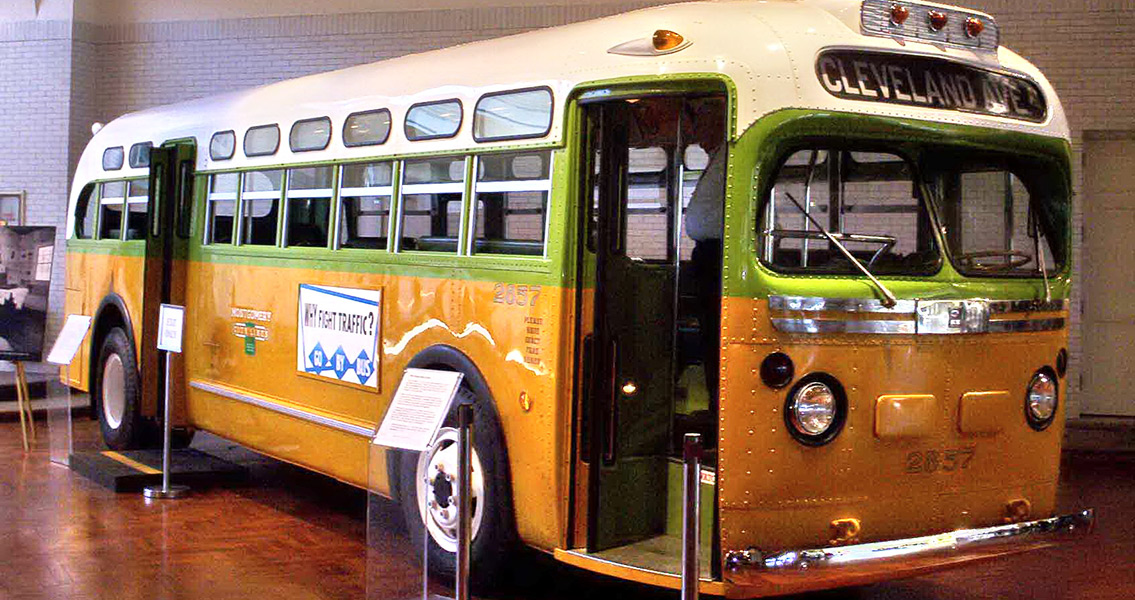<![CDATA[On the 17th February 1956, Martin Luther King Jr. was arrested for his role in the Alabama bus protests. The event symbolised the growing drive for Equal Rights in the United States, and the start of a campaign of peaceful protest which would eventually make King a household name. Often described as being sparked by the December 1955 arrest of Rosa Parks in Montgomery, the origins of the campaign actually started much earlier. Discriminatory laws and policies on Montgomery's transport network were already being looked at by The Women's Political Council, a group of black professionals who campaigned for legal reform, well before Parks' arrest. In a meeting with Montgomery's Mayor in 1954, the WPC had submitted their proposals for changes to the city's bus system. Among other things, they demanded that no black person should be made to stand when 'white' seats were empty, black people should no longer have to pay at the front but enter at the rear of a bus, and buses should stop at every corner in both white and black neighbourhoods. After the meeting had failed to produce any meaningful results, the WPC's president issued a warning to the Mayor of a planned bus boycott. A year after the meeting with Montgomery's mayor, fifteen year old Claudette Colvin was arrested for challenging segregation on a bus in the city. A few months later, Mary Louise Smith, an eighteen year old, was arrested for refusing to yield her seat to another, white passenger. Although these events received some publicity, they failed to generate the reaction that Parks' arrest would in December. King described Parks as, "ideal for the role assigned to her by history, her character was impeccable and her dedication deep-rooted". Parks is remembered as the woman who started the bus boycott, largely because the WPC chose her to be that figure. Following the failed negotiation with the mayor, a case was needed to justify the protest. Parks, a pillar of the black community, was deemed the perfect figure to build the campaign around, while Colvin and Smith, for various reasons, were considered bad figureheads. It might seem cynical now, but the decision to choose Parks reveals the careful planning required at the start of the Civil Rights movement. The Boycott started on the 5th December 1955, with 90% of Montgomery's black community not using the city's buses. At a pubic meeting that evening, the Montgomery Improvement Association (MIA) was formed to coordinate the boycott, and King was elected its president. It was decided that the protest would be long term, and a series of demands were issued to the city's authorities on 8th December. Events quickly escalated, despite the peaceful nature of the protest. In early 1956, King's home was bombed, building the tension in the city. At the start of February, city officials invoked a 1921 law which prohibited interference in the lawful business of the city, and indicted over eighty of the MIA's leaders. King was arrested and charged under the law, his punishment the choice between either a $500 fine or 386 days in prison. The Boycott continued, and coverage of King's trial brought the world's gaze to Alabama. Increasing support for the MIA and King put greater pressure on the city's officials, as well as the US Supreme Court, to resolve the issue. On 5th June the Supreme Court ruled that bus segregation was illegal, and on 20th December 1956 the boycott was lifted after segregation was removed from the Montgomery transport network. Martin Luther King would of course build on his success in Montgomery, and become one of the most recognised Civil Rights leaders in history. The events in 1956 highlighted the formative stage of two trends in American culture which would continue into the 1960s. Firstly, the increasing drive to abolish segregation in American society. Secondly, the importance of using peaceful means to generate widespread sympathy for a cause. Like the imprisonment of Parks, King's trial and punishment were used as a calculated set piece to draw ever more attention to the embarrassing, archaic segregation in American society. Violent protest was not necessary, when simply exposing the workings of a system could shame it into change. Image courtesy of Wikimedia Commons user: rmhermen]]>
Anniversary of Martin Luther King's Bus Boycott Arrest
